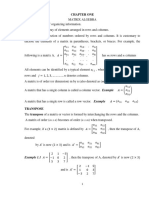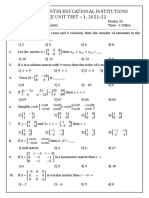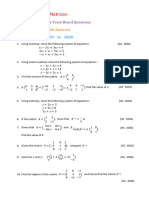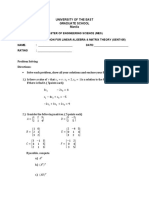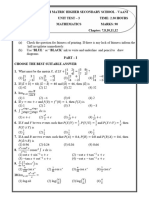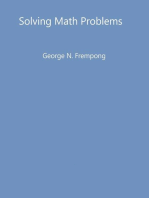Engineering Mathematics4320002 Assignment
Uploaded by
jenishgamdha3318Engineering Mathematics4320002 Assignment
Uploaded by
jenishgamdha3318VPMP POLYTECHNIC, GANDHINAGAR
ENGINEERING MATHEMATICS
COURSE CODE: - 4320002(CE/EE/EC)
ASSIGNMENT
ENGINEERING MATHEMATICS (4320002)
UNIT-I
MARKS-16
MATRICES
ENGINEERING MATHEMATICS (4320002)
MATRICES
MQC’S
2 1 2
1) Order of [ ] is _____.
1 1 1
1 0
2) Order of [0 1] is _____.
3 2
2 −1
3) Order of [ ] is _____.
5 3
1 2
4) If 𝐴 = [ ] then𝐴𝑇 = _______.
3 4
1 −3 4
5) If 𝐴 = [ ] then𝐴𝑇 = _______.
−2 1 2
1 0
6) If 𝐴 = [ ] then𝐴𝑇 = _______.
0 1
1 2
7) If 𝐴 = [3 1] then𝐴𝑇 = _______.
4 2
8) If A is non-singular matrix then ______.
1 4
9) If 𝐴 = [ ] then 3𝐴 = _______.
3 −2
3 2 3 𝑦+1
10) If [ ]=[ ] then (𝑥, 𝑦) = ______.
𝑥−1 5 4 5
𝑥+𝑦 3 8 3
11) Find x and y if [ ]=[ ].
−7 𝑥−𝑦 −7 2
1 1 2 −1
12) [ ]+[ ] = _______.
2 3 −1 1
2 −1 1 2
13) If 𝐴 = [ ] and 𝐵 = [ ] then 2𝐴 + 3𝐵 = ______.
2 0 0 2
1 4
14) If 𝐴 = [ ] then 2𝐴 − 3𝐼 = ______.
3 −2
15) If 𝐴3×4 𝑎𝑛𝑑 𝐵4×4 are the matrices then the order of AB is _______.
16) If 𝐴2×3 𝑎𝑛𝑑 𝐵3×4 are the matrices then the order of (𝐴𝐵)𝑇 is _______.
2 1 3 −1
17) If 𝐴 = [ ] and 𝐵 = [ ] then AB = ______.
5 3 −5 2
1
18) If 𝐴 = [1 2 3] and 𝐵 = [ 0 ] then AB = ______.
−1
1
19) If 𝐴 = [2 0 5] and 𝐵 = [3] then BA = ______.
4
−7 6
20) If 𝐴 = [ ] then 𝐴𝐼 = ______.
5 −2
1
21) If 0 𝑥 −2 [2] = [4] then x = ______.
[ ]
3
1 0
22) If 𝐴 = [ ] then 𝐴2 = ______.
0 1
𝑎 𝑏
23) If 𝐴 = [ ] then 𝑎𝑑𝑗𝐴 = ______.
𝑐 𝑑
ENGINEERING MATHEMATICS (4320002)
1 −2
24) If 𝐴 = [ ] then 𝑎𝑑𝑗𝐴 = ______.
2 −1
−8 4
25) If 𝐴 = [ ] then 𝐴−1 = ______.
−6 3
𝑠𝑖𝑛𝜃 𝑐𝑜𝑠𝜃]
26) If 𝐴 = [ then 𝐴−1 = ______.
−𝑐𝑜𝑠𝜃 𝑠𝑖𝑛𝜃
27) If 𝐴𝐵 = 𝐼 then matrix B =______.
ENGINEERING MATHEMATICS (4320002)
EXAMPLES (Based on Addition , subtraction and equality)
1 −2 4 1 1 2
[
1) If 𝐴 = 0 3 5 𝑎𝑛𝑑 𝐵 = −1 0 7 ] then find 2𝐴 + 3𝐵.
] [
−1 2 6 2 3 −4
1 4 −1 −2
2) If 𝐴 = [3 2] 𝑎𝑛𝑑 𝐵 = [ 0 5 ] then find 3𝐴 − 2𝐵.
2 5 3 1
1 3 5 3 4 5 1 2 1
3) If 𝐴 = [−1 0 2] , 𝐵 = [5 4 3] 𝑎𝑏𝑑 𝐶 = [3 2 2] then find 3𝐴 + 2𝐵 − 4𝐶.
4 3 6 3 5 4 4 5 6
2 3 6 0 2 −8 1 3 −3
4) If 𝐴 = [ ] ,𝐵 = [ ] 𝑎𝑏𝑑 𝐶 = [ ] then prove that
−1 2 5 2 4 −2 1 4 1
2𝐴 + 3𝐵 − 4𝐶 = 0.
1 2 1 3 −2 4
5) If 𝐴 = [ ] 𝑎𝑛𝑑 𝐵 = [ ] then find matrix 𝑋 from 𝑋 + 𝐴 + 𝐵 = 0.
3 4 2 1 5 0
1 2 0
6) If 𝐴 = [ ] 𝑎𝑛𝑑 𝐵 = [ 5 6 3] then find matrix 𝑋 from 3(𝑋 + 𝐵) + 5𝐴 = 0.
−3 2 8 −2 3 2
3 4 −1 −2
7) If 𝐴 = [ ] ,𝐵 = [ ] then prove that (𝐴 + 𝐵)𝑇 = 𝐴𝑇 + 𝐵𝑇 .
1 2 2 1
−2 3 8 15 −6 2
8) If 𝑀 = [ 5 −7 9] , 𝑁 = [11 4 7] then prove that (𝑀 + 𝑁)𝑇 = 𝑀𝑇 + 𝑁 𝑇 .
1 −4 6 13 5 6
2 1 −1 2
9) If 3𝐴 − 2𝐵 = [ ] 𝑎𝑛𝑑 𝐵 − 4𝐴 = [ ] then find 𝐴 𝑎𝑛𝑑 𝐵.
−2 −3 −4 4
𝑎 + 2𝑏 3𝑐 + 2𝑑] [4 0]
10) If [ = then find the values of 𝑎, 𝑏, 𝑐 𝑎𝑛𝑑 𝑑.
2𝑎 − 𝑏 𝑐−𝑑 3 5
EXAMPLES (Based on multiplication)
−1 2 3
1 2 −1
1) If 𝐴 = [ 3 −2 1] 𝑎𝑛𝑑 𝐵 = [ ] find 𝐴𝐵 𝑜𝑟 𝐵𝐴 whichever exist.
3 −1 5
0 1 1
1 2
1 2 3
2) If 𝐴 = [ ] 𝑎𝑛𝑑 𝐵 = [2 1] then find 𝐴𝐵 𝑎𝑛𝑑 𝐵𝐴.
4 5 6
1 2
−1 3 5
3) If 𝐴 = [ 1 −3 −5] then show that 𝐴2 = 𝐴.
−1 3 5
1 2
4) If 𝐴 = [ ] then prove that 𝐴2 − 5𝐴 − 2𝐼 = 0.
3 4
2 3
5) If 𝐴 = [ ] then prove that 𝐴2 − 4𝐴 + 7𝐼 = 0.
−1 2
1 2 2
6) If 𝐴 = [2 1 2] then prove that 𝐴2 − 4𝐴 − 5𝐼 = 0.
2 2 1
0 1
7) If 𝐴 = [ ] then prove that 𝐴4 = 𝐼.
−1 0
2 3
3 1 2
8) If 𝐴 = [ ] 𝑎𝑛𝑑 𝐵 = [3 4] then find (𝐴𝐵)𝑇 .
2 3 4
2 1
2 −2 −1 5
9) If 𝐴 = [ ] 𝑎𝑛𝑑 𝐵 = [ ] then prove that (𝐴𝐵)𝑇 = 𝐵𝑇 . 𝐴𝑇 .
3 1 4 −3
ENGINEERING MATHEMATICS (4320002)
𝑥 3 2
10) From equation [ ] [ ] = [15] find value of 𝑥 𝑎𝑛𝑑 𝑦.
𝑦 2 3 12
2 1 −1 3 1
5 3
11) Evaluate [ 4 −5 6 ] [−6 4] [ ].
−2 1
−3 7 3 −2 5
EXAMPLES (Based on adjoint and inverse)
−4 −3 −3
1) If 𝐴 = [ 1 0 1 ] then prove that 𝑎𝑑𝑗𝐴 = 𝐴.
4 4 3
5 −3 ] then find 𝐴−1 .
2) If 𝐴 = [
2 1
3 5]
3) If 𝐴 = [ then find 𝐴−1 .
−2 −3
5 −7] −16 −6
4) Find matrix 𝑋 such that [ .𝑋 = [ ].
−2 3 7 2
1 −1 3 1
5) If 𝐴 + 𝐵 = [ ] 𝑎𝑛𝑑 𝐴 − 𝐵 = [ ] then find (𝐴𝐵)−1 .
3 0 1 4
1 2 1
6) Find 𝐴−1 if exists for𝐴 = [3 2 3].
1 1 2
3 −1 2
7) Find inverse of matrix [4 1 −1].
5 0 1
1 −1 1
8) If 𝐴 = [2 −1 0] then find 𝐴−1 .
1 0 1
3 −10 −1
9) If 𝐴 = [−2 8 2 ] then find 𝐴−1 .
2 −4 −2
3 1 2
10) If 𝐴 = [2 −3 −1] then find 𝐴−1 .
1 2 1
EXAMPLES (Based on simultaneous linear equation)
1) Solve the equation 3𝑥 − 𝑦 = 1 𝑎𝑛𝑑 𝑥 + 2𝑦 = 5 using matrix method.
2) Solve the equation 2𝑥 + 5𝑦 = 7 𝑎𝑛𝑑 8𝑥 − 3𝑦 = 5 using matrix method.
3) Solve the equation 2𝑥 + 3𝑦 = 1 𝑎𝑛𝑑 𝑦 − 4𝑥 = 2 using matrix method.
4) Solve the equation 2𝑥 − 3𝑦 = −5 𝑎𝑛𝑑 3𝑥 + 𝑦 = 9 using matrix method.
5) Solve the equation 3𝑥 + 2𝑦 = 7 𝑎𝑛𝑑 11𝑥 − 4𝑦 = 3 using matrix method.
6) Solve the equation 3𝑥 + 2𝑦 = 5 𝑎𝑛𝑑 2𝑥 − 𝑦 = 1 using matrix method.
7) Solve the equation 2𝑥 + 3𝑦 = 6𝑥𝑦 𝑎𝑛𝑑 𝑥 − 𝑦 = 𝑥𝑦 using matrix method.
ENGINEERING MATHEMATICS (4320002)
UNIT-II
MARKS-16
DIFFERENTIATION
AND
ITS APPLICATION
ENGINEERING MATHEMATICS (4320002)
DIFFERENTIATION
MCQ’S
d
1) (sin2 x + cos2 x) = _____ .
dx
2) 𝐼𝑓 𝑓(𝑥) = 2𝑥 𝑡ℎ𝑒𝑛 𝑓 ′ (0) = ________ .
𝑑
3) (𝑥 𝑙𝑜𝑔𝑥) = ______ .
𝑑𝑥
4) 𝐼𝑓 𝑓(𝑥) = 𝑒 2𝑥 𝑡ℎ𝑒𝑛 𝑓 ′ (𝑥) = _______ .
𝑑
5) log(𝑐𝑜𝑠𝑥) = _______ .
𝑑𝑥
d
6) (sin−1 x + cos−1 x) = _____ .
dx
d
7) (x x ) = _______ .
dx
𝑑𝑦
8) 𝑥 + 𝑦 2 = 29 𝑡ℎ𝑒𝑛
2
𝑑𝑥
𝑎𝑡 𝑡ℎ𝑒 𝑝𝑜𝑖𝑛𝑡 (2,5) = ______ .
𝑑
9) (𝑐𝑜𝑡𝑥) = ________
𝑑𝑥
𝑑(𝑙𝑜𝑔𝑠𝑖𝑛𝑥)
10) = _______ .
𝑑𝑥
𝑢
𝑑( )
𝑣
11) 𝑑𝑥
= _____ .
𝑑(𝑒 −𝑙𝑜𝑔𝑥 )
12) 𝑑𝑥
= _________ .
𝑑𝑦
13) 𝐼𝑓 𝑥 = 𝑠𝑒𝑐𝜃 + 𝑡𝑎𝑛𝜃 𝑎𝑛𝑑 𝑦 = 𝑠𝑒𝑐𝜃 − 𝑡𝑎𝑛𝜃 𝑡ℎ𝑒𝑛 𝑑𝑥
= ________ .
14) 𝐼𝑓 𝑓(𝑥) = 𝑙𝑜𝑔√𝑥 2 + 1 𝑡ℎ𝑒𝑛 𝑓 ′ (0) = ________ .
𝑎 𝑑𝑦
15) 𝐼𝑓 𝑥 = 𝑎𝑡 𝑎𝑛𝑑 𝑦 = 𝑡ℎ𝑒𝑛 = _________.
𝑡 𝑑𝑥
𝑑 𝑑
16) 𝐼𝑓 (𝑥 𝑛 ) = 𝑛𝑥 𝑛−1 𝑡ℎ𝑒𝑛 (𝑦 4 ) = ________ .
𝑑𝑥 𝑑𝑥
𝑑
17) 𝑑𝑥 (𝑠𝑒𝑐𝑥) = _________ .
𝑑𝑦
18) 𝐼𝑓 𝑥 = 𝑐𝑜𝑠𝜃 𝑎𝑛𝑑 𝑦 = 𝑠𝑖𝑛𝜃 𝑡ℎ𝑒𝑛 = _________ .
𝑑𝑥
𝑑𝑦
19) 𝐼𝑓 𝑥 2 + 𝑦 2 = 1 𝑡ℎ𝑒𝑛 = _________ .
𝑑𝑥
𝜋 𝑑𝑦
20) 𝐼𝑓 𝑦 = 𝑠𝑖𝑛99 ( 2 ) 𝑡ℎ𝑒𝑛 𝑑𝑥
= ______ .
𝑑𝑦
21) 𝐼𝑓 𝑦 = 𝑐𝑜𝑡𝑥 𝑡ℎ𝑒𝑛 𝑑𝑥
= ________ .
𝑑2 𝑦
22) 𝐼𝑓 𝑦 = 𝑒 𝑥 𝑡ℎ𝑒𝑛 𝑑𝑥 2
= _________ .
𝑑
23) 𝑑𝑥 (𝑥 2 + 2𝑥 + 22 ) = _______ .
𝑑
24) 𝑑𝑥 (√𝑥) = _________ .
𝜋
25) 𝐼𝑓 𝑓(𝑥) = 𝑠𝑖𝑛𝑥 𝑡ℎ𝑒𝑛 𝑓 ′ ( 2 ) = _______ .
𝑑
26) 𝑑𝑥 (3𝑠𝑖𝑛𝑥 − 4𝑠𝑖𝑛3 𝑥) =_________ .
𝑑
27) 𝑑𝑥 (𝑎 𝑥 ) = __________ .
d
28) dx (tan−1 x + cot −1 x) = _________ .
ENGINEERING MATHEMATICS (4320002)
𝑑
29) (𝑥 2 + 2𝑥 + 7) = ________ .
𝑑𝑥
𝑑
30) 𝑑𝑥 (𝑡𝑎𝑛𝑥) = ________ .
d
31) dx (tan2 x − sec 2 x) =_______ .
𝑑𝑦
32) 𝐼𝑓 𝑦 = 1,00,000 𝑡ℎ𝑒𝑛 𝑑𝑥
= ________ .
𝑑𝑦
33) 𝐼𝑓 𝑦 = 𝑡𝑎𝑛𝑥 𝑡ℎ𝑒𝑛 𝑑𝑥
= ________ .
𝑑2 𝑦
34) 𝐼𝑓 𝑦 = 𝑒 𝑥 + 4 𝑡ℎ𝑒𝑛 𝑑𝑥 2
= _________ .
𝑑
35) 𝑑𝑥 (𝑐𝑜𝑠𝑒𝑐𝑥) = __________ .
𝑑
36) 𝑑𝑥 (𝑥 𝑛 ) = ______ .
ENGINEERING MATHEMATICS (4320002)
EXAMPLES (Based on Definition )
1) Using definition of derivative, find the derivative of x2 with respect to x.
2) Find the derivative of x3 using definition.
3) Using first principle of differentiation, differentiate √𝑥 with respect to x.
4) Differentiate ax using definition.
5) Find derivative of ex using definition.
6) Find derivative of sinx using definition.
7) Differentiate f(x) = cosx with respect to x by using definition of derivative.
8) Differentiate x2+2x-1 with respect to x by using first principle.
9) Differentiate y = 2x2+3 using definition.
EXAMPLES (Based on Addition , subtraction , Multiplication , division ,Chain rule )
𝑑
1) Find 𝑑𝑥 (𝑥 3 . 𝑙𝑜𝑔𝑥).
𝑑𝑦
2) 𝐼𝑓 𝑦 = 𝑒 𝑥 . 𝑠𝑖𝑛𝑥 𝑡ℎ𝑒𝑛 𝑓𝑖𝑛𝑑 𝑑𝑥
.
𝑑𝑦
3) 𝐼𝑓 𝑦 = 𝑥 2 . 𝑡𝑎𝑛𝑥 𝑡ℎ𝑒𝑛 𝑓𝑖𝑛𝑑 𝑑𝑥
.
𝑑𝑦 𝑙𝑜𝑔𝑥
4) Find 𝑑𝑥 when (I) 𝑦 = 𝑒 𝑥 . 𝑠𝑒𝑐𝑥 (II) 𝑦 = 𝑥
.
𝑠𝑖𝑛𝑥 𝑑𝑦
5) For 𝑦 = 𝑥
find𝑑𝑥 .
𝑙𝑜𝑔𝑥
6) Find the derivative of 𝑥
at x=1.
𝑥 2−1 𝑑𝑦
7) If 𝑦 = 𝑥 2+1 𝑡ℎ𝑒𝑛 𝑓𝑖𝑛𝑑 𝑑𝑥
.
1+𝑠𝑖𝑛𝑥 𝑑𝑦
8) If 𝑦 = 1−𝑠𝑖𝑛𝑥 𝑡ℎ𝑒𝑛 𝑓𝑖𝑛𝑑 𝑑𝑥
.
𝑑𝑦 𝑎+𝑏𝑠𝑖𝑛𝑥
9) Find 𝑑𝑥 if 𝑦 = 𝑏+𝑎𝑠𝑖𝑛𝑥 .
𝑑𝑦 3+4𝑠𝑖𝑛𝑥
10) Find 𝑑𝑥 if 𝑦 = 4+3𝑠𝑖𝑛𝑥 .
1+𝑡𝑎𝑛𝑥 𝑑𝑦
11) If 𝑦 = 1−𝑡𝑎𝑛𝑥 𝑡ℎ𝑒𝑛 𝑓𝑖𝑛𝑑 𝑑𝑥
.
𝑑𝑦
12) If 𝑦 = log(𝑡𝑎𝑛𝑥) + 𝑐𝑜𝑠𝑥 + 𝑥 then find 𝑑𝑥 .
𝑑𝑦
13) Find 𝑑𝑥 for 𝑦 = log(𝑐𝑜𝑠2𝑥) .
𝑑𝑦
14) If 𝑦 = 𝑥 3 . 𝑡𝑎𝑛𝑥 + (𝑡𝑎𝑛𝑥)3 then find .
𝑑𝑥
𝑑𝑦
15) Find 𝑑𝑥 if 𝑦 = log(𝑐𝑜𝑠𝑒𝑐𝑥 − 𝑐𝑜𝑡𝑥) .
𝑑𝑦
16) Find 𝑑𝑥 if 𝑦 = log(𝑠𝑒𝑐𝑥 + 𝑡𝑎𝑛𝑥) .
𝑑𝑦
17) If 𝑦 = 𝑒 3𝑥 . 𝑐𝑜𝑠2𝑥 then find 𝑑𝑥 .
𝑑𝑦
18) If 𝑦 = 𝑒 𝑠𝑖𝑛𝑥 . 𝑠𝑒𝑐2𝑥 then find 𝑑𝑥 .
𝑑𝑦
19) If 𝑦 = 𝑥 3 . sin(𝑙𝑜𝑔𝑥) then find 𝑑𝑥 .
sin(𝑙𝑜𝑔𝑥) 𝑑𝑦
20) If 𝑦 = 𝑥
then find 𝑑𝑥 .
𝑑𝑦 𝑠𝑖𝑛𝑥
21) Find 𝑑𝑥 from 𝑦 = log (1+𝑐𝑜𝑠𝑥 ) .
𝑑𝑦
22) If 𝑦 = 𝑙𝑜𝑔(𝑥 + √𝑥 2 + 1) then find .
𝑑𝑥
ENGINEERING MATHEMATICS (4320002)
𝑎+𝑥 𝑑𝑦
23) If 𝑦 = 𝑙𝑜𝑔√ then find .
𝑎−𝑥 𝑑𝑥
EXAMPLES (Based on taking log on both side)
𝑑𝑦
1) If 𝑦 = 𝑥 𝑥 then find𝑑𝑥 .
𝑑𝑦
2) If 𝑦 = 𝑥 𝑠𝑖𝑛𝑥 then find𝑑𝑥 .
𝑑𝑦
3) If 𝑦 = 𝑠𝑖𝑛𝑥 𝑥 then find𝑑𝑥 .
𝑑𝑦
4) If 𝑦 = (𝑠𝑖𝑛𝑥)𝑡𝑎𝑛𝑥 then find .
𝑑𝑥
𝑑𝑦
5) If 𝑦 = (𝑠𝑖𝑛𝑥 )𝑐𝑜𝑠𝑥 then find𝑑𝑥 .
𝑑𝑦
6) If 𝑦 = 𝑥 𝑥 + (𝑠𝑖𝑛𝑥) 𝑥 then find𝑑𝑥 .
EXAMPLES (Based on Implicit function)
𝑑𝑦
1) If 𝑥 2 + 𝑦 2 = 𝑥𝑦 then find𝑑𝑥 .
𝑑𝑦
2) If 𝑥 3 + 𝑦 3 = 3𝑥𝑦 then find𝑑𝑥 .
𝑑𝑦
3) If 𝑥 3 + 𝑦 3 = 3𝑎𝑥𝑦 then find .
𝑑𝑥
𝑑𝑦
4) If 𝑥 + 𝑦 = 𝑠𝑖𝑛(𝑥𝑦) then find𝑑𝑥 .
𝑑𝑦
5) If 𝑦 = 𝑠𝑖𝑛(𝑥 + 𝑦) then find𝑑𝑥 .
𝑑𝑦
6) If 𝑦 = 𝑐𝑜𝑠(𝑥 + 𝑦) then find𝑑𝑥 .
𝑑𝑦
7) If 𝑥𝑠𝑖𝑛𝑦 + 𝑦𝑠𝑖𝑛𝑥 = 5 then find𝑑𝑥 .
𝑑𝑦
8) If a𝑥 2 + 2ℎ𝑥𝑦 + 𝑏𝑦 2 = 0 then find .
𝑑𝑥
EXAMPLES (Based on Parametric function)
𝑑𝑦
1) If 𝑥 = 𝑎𝑡 2 𝑎𝑛𝑑 𝑦 = 2𝑎𝑡 then find𝑑𝑥 .
𝑑𝑦
2) If 𝑥 = 𝑎𝑠𝑖𝑛𝜃 𝑎𝑛𝑑 𝑦 = 𝑎(1 + 𝑐𝑜𝑠𝜃) then find𝑑𝑥 .
𝑑𝑦
3) If 𝑥 = 𝑎(𝜃 + 𝑠𝑖𝑛𝜃) 𝑎𝑛𝑑 𝑦 = 𝑎(1 − 𝑐𝑜𝑠𝜃) then find .
𝑑𝑥
𝑑𝑦
4) If 𝑥 = 𝑎(1 + 𝑐𝑜𝑠𝜃) 𝑎𝑛𝑑 𝑦 = 𝑏(𝜃 + 𝑠𝑖𝑛𝜃) then find𝑑𝑥 .
𝑑𝑦
5) If 𝑥 = 𝑠𝑒𝑐𝜃 + 𝑡𝑎𝑛𝜃 𝑎𝑛𝑑 𝑦 = 𝑠𝑒𝑐𝜃 − 𝑡𝑎𝑛𝜃 then find𝑑𝑥 .
1 1 1 1 𝑑𝑦
6) If 𝑥 = 2 (𝑡 + 𝑡 ) 𝑎𝑛𝑑 𝑦 = 2 (𝑡 − 𝑡 ) then find𝑑𝑥 .
𝑑𝑦
7) If 𝑥 = 𝑒 2𝑡 𝑐𝑜𝑠𝑡 𝑎𝑛𝑑 𝑦 = 𝑒 2𝑡 𝑠𝑖𝑛𝑡 then find .
𝑑𝑥
ENGINEERING MATHEMATICS (4320002)
EXAMPLES (Based on Successive differentiation )
𝑑2 𝑦 𝑑𝑦 2
1) If 𝑦 = 𝑙𝑜𝑔(𝑠𝑖𝑛𝑥) then prove that 𝑑𝑥 2 + (𝑑𝑥 ) + 1 = 0.
𝑑𝑦
2) If 𝑦 = 𝑙𝑜𝑔(𝑒 𝑠𝑖𝑛𝑥 ) then prove that − 𝑐𝑜𝑠𝑥 = 0.
𝑑𝑥
𝑑2 𝑦 𝑑𝑦
3) If 𝑦 = 𝑒 2𝑥 then prove that 𝑑𝑥 2 − 5 𝑑𝑥 + 6𝑦 = 0.
4) If 𝑥 = 𝑎𝑡 2 𝑎𝑛𝑑 𝑦 = 2𝑎𝑡 then prove that 𝑦𝑦2+ 𝑦12 = 0.
𝑑2 𝑦 𝑑𝑦
5) If 𝑦 = 2𝑒 3𝑥 + 3𝑒 −2𝑥 then prove that 𝑑𝑥 2 − 𝑑𝑥 − 6𝑦 = 0.
𝑑2 𝑦
6) If 𝑦 = 𝐴𝑐𝑜𝑠𝑝𝑡 + 𝐵𝑠𝑖𝑛𝑝𝑡 then prove that 𝑑𝑡 2 + 𝑝2 𝑦 = 0.
EXAMPLES (Based on application of differentiation Maximum and Minimum )
1) Find maximum and minimum values of 𝑓 (𝑥) = 𝑥 3 − 3𝑥 + 11.
2) Find maximum and minimum values of 𝑓 (𝑥) = 2𝑥 3 − 3𝑥 2 − 12𝑥 + 5.
3) Find maximum and minimum values of 𝑓 (𝑥) = 2𝑥 3 − 15𝑥 2 + 36𝑥 + 10.
4) Find maximum and minimum values of 𝑓 (𝑥) = 𝑥 3 + 𝑥 2 − 𝑥.
5) Find maximum and minimum values of 𝑓 (𝑥) = 3𝑥 3 − 4𝑥 2 − 𝑥 + 5.
1
6) Find maxima and minima of 𝑓 (𝑥) = 𝑥 + 𝑥 .
EXAMPLES (Based on application of differentiation Velocity and Acceleration )
1) The equation of motion of particle is 𝑠 = 𝑡 3 − 6𝑡 2 + 8𝑡 − 4 then find velocity and acceleration
of the moving particle at 𝑡 = 3 𝑠𝑒𝑐𝑜𝑛𝑑.
2) The distance of a moving particle is given by 𝑠 = 𝑡 3 − 3𝑡 2 + 4𝑡 + 3. Find velocity and
acceleration at 𝑡 = 2 𝑠𝑒𝑐𝑜𝑛𝑑.
3) If the law of motion is 𝑠 = 𝑡 3 + 6𝑡 2 + 3𝑡 + 5 then find velocity and acceleration
at 𝑡 = 3𝑠𝑒𝑐𝑜𝑛𝑑.
4) The equation of motion of particle is 𝑠 = 𝑡 3 − 6𝑡 2 + 9𝑡 then find velocity and acceleration
at 𝑡 = 3 𝑠𝑒𝑐𝑜𝑛𝑑.
5) The motion of particle is given by 𝑠 = 𝑡 3 − 6𝑡 2 + 9𝑡 + 6 then find velocity when acceleration is
zero.
6) The equation of motion of particle is 𝑠 = 𝑡 3 − 5𝑡 2 + 3𝑡. When particle comes to rest? Find
acceleration at that time.
7) A particle has motion of 𝑠 = 2𝑡 3 + 3𝑡 2 − 12𝑡 + 6. Find velocity and acceleration at
𝑡 = 2 𝑠𝑒𝑐𝑜𝑛𝑑. Also find acceleration when particle comes to rest.
8) The equation of motion of particle is 𝑠 = 𝑡 3 − 6𝑡 2 + 9𝑡 then find 𝑡 𝑎𝑛𝑑 𝑠 𝑎𝑡 𝑣 = 0.
9) The equation of motion of particle is 𝑠 = 𝑡 3 − 6𝑡 2 + 9𝑡 + 6 where s is in meter and t is in
second. (I) Find 𝑣 𝑎𝑛𝑑 𝑎 𝑤ℎ𝑒𝑛 𝑡 = 2𝑠𝑒𝑐𝑜𝑛𝑑. (II) Find s when particle change its direction.
10) The equation of motion of particle is 𝑠 = 𝑡 3 + 3𝑡 (𝑡 > 0).
(I) Find velocity and acceleration at 𝑡 = 3𝑠𝑒𝑐𝑜𝑛𝑑.
(II) When do velocity and acceleration become equal?
ENGINEERING MATHEMATICS (4320002)
UNIT-III
MARKS-14
INTEGRATION
AND
ITS APPLICATION
ENGINEERING MATHEMATICS (4320002)
INTEGRATION
MCQ’S
1) ∫ 𝑥 3 𝑑𝑥 = _______ + 𝑐.
2) ∫ 𝑥 4 𝑑𝑥 = _______ + 𝑐.
3) ∫ 𝑥 7 𝑑𝑥 = _______ + 𝑐.
1
4) ∫ 𝑥 2 𝑑𝑥 = _______ + 𝑐.
5) ∫ 𝑙𝑜𝑔𝑥 𝑑𝑥 = _______ + 𝑐.
6) ∫ 𝑠𝑖𝑛𝑥 𝑑𝑥 = _______ + 𝑐.
7) ∫ 𝑐𝑜𝑠𝑥 𝑑𝑥 = _______ + 𝑐.
8) ∫(sin2 x + cos2 x) 𝑑𝑥 = _______ + 𝑐.
9) ∫ tan2 x 𝑑𝑥 = _______ + 𝑐.
10) ∫ 𝑡𝑎𝑛𝑥 𝑑𝑥 = _______ + 𝑐.
11) ∫ 𝑒 𝑥𝑙𝑜𝑔𝑎 𝑑𝑥 = _______ + 𝑐.
12) ∫ 𝑒 −log(𝑠𝑒𝑐𝑥) 𝑑𝑥 = _______ + 𝑐.
1
13) ∫ 1+𝑥 2 𝑑𝑥 = _______ + 𝑐.
1
14) ∫ √𝑎2 𝑑𝑥 = _______ + 𝑐.
−𝑥 2
1
15) ∫ 𝑥 2+25 𝑑𝑥 = _______ + 𝑐.
1
16) ∫ 𝑑𝑥 = _______ + 𝑐.
√1−𝑥 2
17) ∫ cos(𝑎𝑥 + 𝑏) 𝑑𝑥 = _______ + 𝑐.
18) ∫(√1 + 𝑠𝑖𝑛2𝑥) 𝑑𝑥 = _______ + 𝑐.
1
19) ∫0 𝑒 𝑥 𝑑𝑥 = _______ + 𝑐.
1
20) ∫0 𝑥 𝑑𝑥 = _______ + 𝑐.
5
21) ∫2 𝑥 3 𝑑𝑥 = _______ + 𝑐.
1
22) ∫−1 𝑥 3 𝑑𝑥 = _______ + 𝑐.
𝒆 𝑑𝑥
23) ∫1 = _______ + 𝑐.
𝑥
1
24) ∫−1(𝑥 2 + 1) 𝑑𝑥 = _______ + 𝑐.
𝑒
25) ∫1 𝑙𝑜𝑔𝑥 𝑑𝑥 = _______ + 𝑐.
𝒙( 2 )
26) ∫ 𝒆 tanx + sec x 𝑑𝑥 = _______ + 𝑐.
1 1
27) ∫ 𝑒 𝑥 (𝑥 − 𝑥 2) 𝑑𝑥 = _______ + 𝑐.
28) Area covered by the curve 𝑥 2 + 𝑦 2 = 4 is _______.
ENGINEERING MATHEMATICS (4320002)
EXAMPLES (Based on Addition and subtraction)
1) Evaluate ∫ 4𝑥 2 + 3𝑥 + 9 𝑑𝑥.
2𝑥 2−3𝑥−11
2) Evaluate ∫ ( 𝑥
) 𝑑𝑥.
3𝑥 2+2𝑥−5
3) Evaluate ∫ ( ) 𝑑𝑥.
𝑥
𝑥 3+5𝑥 2+4𝑥+1
4) Evaluate ∫ ( ) 𝑑𝑥.
𝑥2
𝑥 2+5𝑥+6
5) Evaluate ∫ 𝑑𝑥.
𝑥 2+2𝑥
𝟏 2
6) Evaluate ∫ (𝑥 + 𝒙) 𝑑𝑥.
𝟏 2
7) Evaluate ∫ (√𝑥 − ) 𝑑𝑥.
√𝒙
𝑥 4+𝑥 2+1
8) Evaluate ∫ 𝑥 2+1
𝑑𝑥.
𝑥 2+4𝑥+1
9) Evaluate ∫ 𝑥 3+𝑥
𝑑𝑥.
2+3𝑠𝑖𝑛𝑥
10) Evaluate ∫ 𝑐𝑜𝑠 2 𝑥
𝑑𝑥.
4+3𝑐𝑜𝑠𝑥
11) Evaluate ∫ 𝑠𝑖𝑛2𝑥
𝑑𝑥.
𝑠𝑖𝑛3𝑥+𝑐𝑜𝑠 3 𝑥
12) Evaluate ∫ 𝑠𝑖𝑛2 𝑥.𝑐𝑜𝑠 2 𝑥
𝑑𝑥.
1
13) Evaluate ∫ 𝑠𝑖𝑛2𝑥.𝑐𝑜𝑠2 𝑥 𝑑𝑥.
14) Evaluate ∫ 𝑠𝑒𝑐 2 𝑥. 𝑐𝑜𝑠𝑒𝑐 2 𝑥 𝑑𝑥.
𝑐𝑜𝑠2𝑥
15) Evaluate ∫ 𝑑𝑥.
𝑠𝑖𝑛2𝑥.𝑐𝑜𝑠 2 𝑥
𝑑𝑥
16) Evaluate ∫ 1−𝑠𝑖𝑛𝑥 .
𝑐𝑜𝑠𝑥
17) Evaluate ∫ 𝑑𝑥.
1+𝑐𝑜𝑠𝑥
EXAMPLES (Based on integration by parts)
1) Evaluate ∫ 𝑥. 𝑒 𝑥 𝑑𝑥.
2) Evaluate ∫ 𝑠𝑖𝑛𝑥. 𝑥 𝑑𝑥.
3) Evaluate ∫ 𝑥. 𝑐𝑜𝑠𝑥 𝑑𝑥.
4) Evaluate ∫ 𝑥. 𝑙𝑜𝑔𝑥 𝑑𝑥.
5) Evaluate ∫ 𝑥. 𝑒 𝑚𝑥 𝑑𝑥.
6) Evaluate ∫ 𝑥. 𝑒 3𝑥 𝑑𝑥.
7) Evaluate ∫ 𝑥 2 . 𝑙𝑜𝑔𝑥 𝑑𝑥.
8) Evaluate ∫ 𝑥 2 . 𝑒 𝑥 𝑑𝑥.
9) Evaluate ∫ 𝑥. tan−1 𝑥 𝑑𝑥.
10) Evaluate ∫ 𝑙𝑜𝑔𝑥 𝑑𝑥.
ENGINEERING MATHEMATICS (4320002)
EXAMPLES (Based on substitution method)
1) Evaluate ∫ 𝑒 𝑠𝑖𝑛𝑥 . 𝑐𝑜𝑠𝑥 𝑑𝑥.
2) Evaluate ∫ 𝑒 𝑐𝑜𝑠𝑥 . 𝑠𝑖𝑛𝑥 𝑑𝑥.
3) Evaluate ∫ 𝑒 𝑡𝑎𝑛𝑥 . 𝑠𝑒𝑐 2 𝑥 𝑑𝑥.
4) Evaluate ∫ 𝑠𝑖𝑛5 𝑥. 𝑐𝑜𝑠𝑥 𝑑𝑥.
5) Evaluate ∫ 𝑐𝑜𝑠𝑥. √𝑠𝑖𝑛𝑥 𝑑𝑥.
𝑠𝑖𝑛(𝑙𝑜𝑔𝑥)
6) Evaluate ∫ 𝑥
𝑑𝑥.
(𝑙𝑜𝑔𝑥)5
7) Evaluate ∫ 𝑑𝑥.
𝑥
2tan−1 𝑥
8) Evaluate ∫ 1+𝑥 2
𝑑𝑥.
𝑒 𝑥(𝑥+1)
9) Evaluate ∫ 𝑠𝑖𝑛2(𝑥𝑒 𝑥) 𝑑𝑥.
𝑒 𝑥(𝑥+1)
10) Evaluate ∫ 𝑑𝑥.
𝑐𝑜𝑠 2 (𝑥𝑒 𝑥 )
𝑥2
11) Evaluate ∫ 2𝑥. 𝑒 𝑑𝑥.
𝑥2
12) Evaluate ∫ 𝑑𝑥.
1+𝑥 6
13) Evaluate ∫ 2𝑥. (𝑥 2 + 8)8 𝑑𝑥.
14) Evaluate ∫(2𝑥 + 1)√𝑥 2 + 𝑥 + 9 𝑑𝑥.
EXAMPLES (Based on partial fraction)
𝑑𝑥
1) Evaluate ∫ 𝑥 2−3𝑥+2.
𝑥
2) Evaluate ∫ (𝑥+1)(𝑥+2) 𝑑𝑥.
𝑥+3
3) Evaluate ∫ (𝑥−1)(𝑥−2) 𝑑𝑥.
2𝑥+1
4) Evaluate ∫ (𝑥+1)(𝑥−3) 𝑑𝑥.
2𝑥+3
5) Evaluate ∫ (𝑥−1)(𝑥+2) 𝑑𝑥.
EXAMPLES (Based on definite integration)
3
1) Evaluate ∫1 (𝑥 2 + 𝑥 + 1) 𝑑𝑥.
2
2) Evaluate ∫1 (𝑥 2 + 4𝑥 + 1) 𝑑𝑥.
3
3) Evaluate ∫1 (2𝑥 2 + 5𝑥 + 1) 𝑑𝑥.
2 𝑥 3−1
4) Evaluate ∫1 𝑥−1
𝑑𝑥.
1 𝑥 3−8
5) Evaluate ∫−1 𝑥−2 𝑑𝑥.
1 2
6) Evaluate ∫0 1+𝑥 2 𝑑𝑥.
3 2𝑥
7) Evaluate ∫1 1+𝑥 2 𝑑𝑥.
2 𝑥2
8) Evaluate ∫0 1+𝑥 3 𝑑𝑥.
2 𝑥
9) Evaluate ∫−1 𝑥 2+3 𝑑𝑥.
ENGINEERING MATHEMATICS (4320002)
𝑒 (𝑙𝑜𝑔𝑥)2
10) Evaluate ∫1 𝑥
𝑑𝑥.
1 tan−1 𝑥
11) Evaluate ∫0 𝑑𝑥.
1+𝑥 2
1 𝑥
12) Evaluate ∫0 𝑑𝑥.
𝑥+1
−3 𝑥
13) Evaluate ∫−4 7+𝑥 𝑑𝑥.
EXAMPLES (Based on definite integration for continuous function)
𝜋
𝑠𝑖𝑛𝑥
1) Evaluate ∫02 𝑑𝑥.
𝑠𝑖𝑛𝑥+𝑐𝑜𝑠𝑥
𝜋
𝑡𝑎𝑛𝑥
2) Evaluate ∫02 𝑡𝑎𝑛𝑥+𝑐𝑜𝑡𝑥 𝑑𝑥.
𝜋
𝑠𝑒𝑐𝑥
3) Evaluate ∫02 𝑠𝑒𝑐𝑥+𝑐𝑜𝑠𝑒𝑐𝑥 𝑑𝑥.
𝜋
√𝑡𝑎𝑛𝑥
4) Evaluate ∫02 𝑑𝑥.
√𝑡𝑎𝑛𝑥+√𝑐𝑜𝑡𝑥
𝜋
√𝑠𝑒𝑐𝑥
5) Evaluate ∫02 𝑑𝑥.
√𝑠𝑒𝑐𝑥+√𝑐𝑜𝑠𝑒𝑐𝑥
𝜋 3
√𝑠𝑖𝑛𝑥
6) Evaluate ∫02 3 3 𝑑𝑥.
√𝑠𝑖𝑛𝑥 + √𝑐𝑜𝑠𝑥
𝜋
1
7) Evaluate ∫0 2
1+√𝑡𝑎𝑛𝑥
𝑑𝑥.
𝜋
8) Evaluate ∫0 𝑙𝑜𝑔(𝑡𝑎𝑛𝑥) 𝑑𝑥.
2
𝜋
9) Evaluate ∫02 𝑙𝑜𝑔(𝑐𝑜𝑡𝑥) 𝑑𝑥.
5 √5−𝑥
10) Evaluate ∫0 𝑑𝑥 .
√𝑥+√5−𝑥
7 √7−𝑥
11) Evaluate ∫0 𝑑𝑥 .
√𝑥+√7−𝑥
EXAMPLES (Based on application of integration area and volume)
1) Find the area bounded by the curve 𝑥 2 + 𝑦 2 = 𝑎2.
2) Show that the area enclosed between the parabola 𝑦 = 𝑥 2 and lines 𝑥 = 2, 𝑥 = 3 𝑎𝑛𝑑 𝑥 − 𝑎𝑥𝑖𝑠
19
is 3
𝑠𝑞. 𝑢𝑛𝑖𝑡.
3) Find the area of region bounded by 𝑦 = 2𝑥 2 , 𝑥 − 𝑎𝑥𝑖𝑠 and lines 𝑥 = 5.
4) Find the area of region bounded by 𝑦 = 3𝑥 2 , 𝑥 = 2, 𝑥 = 3 𝑎𝑛𝑑 𝑥 − 𝑎𝑥𝑖𝑠.
5) Find the area of region bounded by 𝑦 = 4𝑥 2 , 𝑥 = 1, 𝑥 = 2.
6) Find the area of region bounded by the curves 𝑦 = 𝑥 2 𝑎𝑛𝑑 𝑦 = 𝑥.
7) Find the area of region bounded by the curves 𝑦 = 𝑥 2 𝑎𝑛𝑑 𝑡ℎ𝑒 𝑙𝑖𝑛𝑒 𝑦 = 𝑥 + 2.
8) Find the area of region bounded by the curves 𝑦 2 = 4𝑥 𝑎𝑛𝑑 𝑥 = 2.
9) Find the area of region bounded by the curves 𝑦 = 𝑥 2 − 7𝑥 + 10 𝑎𝑛𝑑 𝑥 − 𝑎𝑥𝑖𝑠.
10) Find the area bounded by the curves 𝑥 + 𝑦 = 1 𝑎𝑛𝑑 𝑡ℎ𝑒 𝑎𝑥𝑒𝑠.
11) Find the volume of a sphere of radius r by method of integration.
ENGINEERING MATHEMATICS (4320002)
UNIT-IV
MARKS-12
DIFFERENTIAL
EQUATIONS
ENGINEERING MATHEMATICS (4320002)
DIFFERENTIAL EQUATIONS
MCQ’S
3
𝑑2𝑦 𝑑𝑦 2
1) The order and degree of the differential equation (𝑑𝑥 2 ) + 3 (𝑑𝑥 ) − 5𝑦 = 0 are ______
respectively.
2 4
𝑑3𝑦 𝑑2 𝑦
2) The order of the differential equation (𝑑𝑥 3 ) + 3 (𝑑𝑥 2 ) + 𝑥𝑠𝑖𝑛𝑦 = 0 is______.
𝑑2 𝑦 𝑑𝑦 2
3) Order of the differential equation + ( ) = 𝑥𝑦 is given by_______.
𝑑𝑥 2 𝑑𝑥
𝑑2 𝑦 𝑑𝑦 3
4) The order of the differential equation 𝑥 𝑑𝑥 2 − 5 (𝑑𝑥 ) − 2𝑦 = 14 is_______.
𝑑𝑦 𝑑2𝑦
5) The degree of the differential equation 𝑥 2 𝑑𝑥 + 𝑠𝑖𝑛 (𝑑𝑥 2 ) = 0 is________.
𝑑2𝑦 𝑑𝑦
6) Order of −5 + 6 = 0 is_______.
𝑑𝑥 2 𝑑𝑥
𝑑2 𝑦 𝑑𝑦 3
7) The order of the differential equation 𝑑𝑥 2 = (3 + 𝑑𝑥 ) is_______.
3
𝑑2𝑦 𝑑𝑦 2
8) The order and degree of the differential equation (𝑑𝑥 2 ) + 3 (𝑑𝑥 ) − 9𝑦 = 0 are ______
and______respectively.
𝑑𝑦
9) For the differential equation + 𝑃𝑦 = 𝑄, Integrating factor is________.
𝑑𝑥
𝑑𝑦 2𝑦
10) Integrating factor of + = 𝑒 𝑥 is______.
𝑑𝑥 𝑥
𝑑𝑦
11) The integrating factor of the equation 𝑑𝑥 = 𝑦𝑡𝑎𝑛𝑥 + 𝑒 𝑥 is________.
𝑑𝑦
12) The integrating factor of the equation + 𝑦 = 3𝑥 is________.
𝑑𝑥
𝑑𝑦 𝑦
13) The integrating factor of the equation 𝑑𝑥 + 𝑥 = 𝑥 is________.
𝑑𝑦
14) The integrating factor of the equation 𝑑𝑥 + 2𝑦 = 𝑒 𝑥 is________.
𝑑𝑦
15) The integrating factor of the equation 𝑑𝑥 + 𝑦𝑡𝑎𝑛𝑥 = 𝑐𝑜𝑠𝑥 is________.
ENGINEERING MATHEMATICS (4320002)
EXAMPLES (Based on Separable variable)
3
2
𝑑𝑦 2 2 𝑑2𝑦
1) Find the order and degree of [1 + ( ) ] = 𝜌 ( 2
) .
𝑑𝑥 𝑑𝑥
2) Find the differential equation for 𝑦 = asin(𝑥 + 𝑏), where 𝑎 𝑎𝑛𝑑 𝑏 are arbitrary constants.
3) Form the differential equation whose general solution is 𝑦 = 𝐴𝑐𝑜𝑠𝑥 + 𝐵𝑠𝑖𝑛𝑥.
𝑑𝑦 𝑦
4) Solve 𝑑𝑥 = 𝑥 .
5) Solve the differential equation 𝑥. 𝑑𝑦 + 𝑦. 𝑑𝑥 = 0.
6) Solve 𝑥 (1 + 𝑦 2 )𝑑𝑥 − 𝑦(1 + 𝑥 2 )𝑑𝑦 = 0.
7) Solve (1 + 𝑥 2 )𝑑𝑥 = (1 + 𝑦 2 )𝑑𝑦.
8) Solve (1 + 𝑥 2 )𝑑𝑦 − (1 + 𝑦 2 )𝑑𝑥 = 0.
𝑑𝑦
9) Solve 𝑑𝑥 + 𝑥 2 . 𝑒 −𝑦 = 0.
𝑑𝑦
10) Solve 𝑥 + 𝑐𝑜𝑡𝑦 = 0.
𝑑𝑥
11) Solve the differential equation 𝑡𝑎𝑛𝑦 𝑑𝑥 + 𝑡𝑎𝑛𝑥. 𝑠𝑒𝑐 2 𝑦 𝑑𝑦 = 0.
12) Solve the differential equation 𝑠𝑒𝑐 2 𝑥. 𝑡𝑎𝑛𝑦 𝑑𝑥 + 𝑠𝑒𝑐 2 𝑦. 𝑡𝑎𝑛𝑥 𝑑𝑦 = 0.
𝜋 𝜋
13) Solve 𝑠𝑒𝑐 2 𝑥. 𝑡𝑎𝑛𝑦 𝑑𝑥 + 𝑠𝑒𝑐 2 𝑦. 𝑡𝑎𝑛𝑥 𝑑𝑦 = 0 𝑤ℎ𝑒𝑟𝑒 𝑦 ( ) = .
4 4
14) Solve 𝑥. 𝑐𝑜𝑠 2 𝑦 𝑑𝑥 = 𝑦. 𝑐𝑜𝑠 2 𝑥 𝑑𝑦.
EXAMPLES (Based on Linear differential equation)
𝑑𝑦 2𝑦
1) Solve + = 𝑠𝑖𝑛𝑥.
𝑑𝑥 𝑥
𝑑𝑦
2) Solve 𝑑𝑥 + 2𝑦 = 𝑒 𝑥 .
𝑑𝑦
3) Solve + 𝑦𝑡𝑎𝑛𝑥 = 𝑐𝑜𝑠𝑥.
𝑑𝑥
𝑑𝑦
4) Solve 𝑑𝑥 + 𝑦𝑡𝑎𝑛𝑥 = 𝑠𝑒𝑐𝑥.
𝑑𝑦
5) Solve 𝑑𝑥 + 𝑦𝑐𝑜𝑡𝑥 = 𝑐𝑜𝑠𝑥.
𝑑𝑦
6) Solve + 𝑦𝑡𝑎𝑛𝑥 = 𝑠𝑒𝑐 2 𝑥.
𝑑𝑥
𝑑𝑦
7) Solve 𝑥 𝑑𝑥
− 𝑦 = 𝑥2 .
𝑑𝑦
8) Solve 𝑐𝑜𝑠𝑥 + 𝑦 = 𝑠𝑖𝑛𝑥.
𝑑𝑥
2 𝑑𝑦
9) Solve 𝑐𝑜𝑠 𝑥 𝑑𝑥 + 𝑦 = 𝑡𝑎𝑛𝑥.
𝑑𝑦
10) Solve 𝑥 𝑙𝑜𝑔𝑥 𝑑𝑥 + 𝑦 = 𝑙𝑜𝑔𝑥 2 .
𝑑𝑦
11) Solve (1 + 𝑥 2 ) 𝑑𝑥 + 𝑦 = tan−1 𝑥.
𝑑𝑦
12) Solve 𝑥 + 2𝑦 = 𝑙𝑜𝑔𝑥.
𝑑𝑥
𝑑𝑦 4𝑥 1
13) Solve 𝑑𝑥 + 𝑥 2+1 𝑦 = (𝑥 2+1)3 .
ENGINEERING MATHEMATICS (4320002)
UNIT-V
MARKS-12
COMPLEX
NUMBERS
ENGINEERING MATHEMATICS (4320002)
COMPLEX NUMBER
MCQ’S
1) 𝑖 8 = ______.
2) 𝑖 9 = ______.
3) 𝑖 + 𝑖 2 + 𝑖 3 + 𝑖 4 = ________.
4) √−4 = _______.
5) √−9 + 0𝑖 = _______.
6) If 𝑧 = 5 − 2𝑖 𝑡ℎ𝑒𝑛 𝑧̅ = ______.
7) If 𝑧 = 3𝑖 − 2 𝑡ℎ𝑒𝑛 𝑧̅ = ______.
8) 𝑧 + 𝑧̅ = ______.
9) For 𝑧 ∈ 𝑐, 𝑧 − 𝑧̅ = ______.
10) If 𝑧̅ = 𝑐𝑜𝑠𝜃 + 𝑖𝑠𝑖𝑛𝜃 then 𝑧 + 𝑧̅ = ______.
11) If ̅̅
|𝑧̅̅| = 16, 𝑡ℎ𝑒𝑛 |𝑧| = _____.
12) If 𝑧 = 3 − 4𝑖 𝑡ℎ𝑒𝑛 |𝑧| = _____.
13) |(3 − 4𝑖 )2 | = _____.
3 4
14) If 𝑧 = − 𝑖 𝑡ℎ𝑒𝑛 |𝑧| = _____.
5 5
15) If 𝑧1 = 2 + 2𝑖 and 𝑧2 = −3 − 2𝑖 𝑡ℎ𝑒𝑛 |𝑧1 + 𝑧2 | = _____.
16) An argument of 1 + 𝑖 = _____.
17) Amplitude of 1 − √3𝑖 is _____.
18) If 𝑧 = −5𝑖 𝑡ℎ𝑒𝑛 arg(𝑧) = ______.
19) arg(35) = ______.
20) arg(−1) = ______.
21) (2 + 3𝑖 )(3 − 2𝑖 ) = ______.
1−𝑖
22) 1+𝑖 = ______.
23) (1 + 𝑖 )2 = _____.
24) Inverse of the number 3 + 4𝑖 is ______.
25) (1 + 𝑖 )−1 = _____.
26) Inverse of the number 5 − 4𝑖 is ______.
27) Inverse of the number 𝑖 is ______.
28) If 3𝑥 + 2𝑦𝑖 = 6 + 4𝑖 𝑡ℎ𝑒𝑛 (𝑥, 𝑦) = _____.
29) If 𝑥 + 4𝑖𝑦 = 𝑥𝑖 + 𝑦 + 3 𝑡ℎ𝑒𝑛 (𝑥, 𝑦) = _____.
30) [𝑐𝑜𝑠𝜃 + 𝑖𝑠𝑖𝑛𝜃]4 + [𝑐𝑜𝑠𝜃 + 𝑖𝑠𝑖𝑛𝜃]−4 = ______.
1
31) If 𝑧 = 𝑐𝑜𝑠𝜃 + 𝑖𝑠𝑖𝑛𝜃 𝑡ℎ𝑒𝑛 𝑧 3 + 𝑧 3 = _____.
ENGINEERING MATHEMATICS (4320002)
EXAMPLES (Based on 𝒙 + 𝒊𝒚 𝒐𝒓 𝒂 + 𝒊𝒃 form, conjugate, modulus and inverse)
5+2𝑖
1) Express into 𝑥 + 𝑖𝑦 form 2+3𝑖 .
4+2𝑖
2) Express (3+2𝑖)(5−3𝑖)
in 𝑎 + 𝑖𝑏 form.
1+7𝑖
3) Express the complex number (2−𝑖)2 in the form of 𝑥 + 𝑖𝑦. 𝑥, 𝑦 ∈ 𝑅.
(1+𝑖)2
4) If 3+𝑖
= 𝑥 + 𝑖𝑦, then find the value of 𝑥 + 𝑦.
3+7𝑖
5) If 𝑧 = then find its conjugate complex and modulus.
1−𝑖
1−𝑖
6) Find complex conjugate and modulus of 𝑧 = 1+𝑖 .
7) Find 𝑥, 𝑦 ∈ 𝑅 from the equation (2𝑥 − 𝑦) + 2𝑦𝑖 = 6 + 4𝑖.
8) Find 𝑥, 𝑦 ∈ 𝑅 from the equation (3𝑥 − 7) + 2𝑖𝑦 = 5𝑦 + (5 + 𝑥)𝑖.
2+3𝑖
9) Find the inverse of complex number 4−3𝑖 .
EXAMPLES (Based on square root, modulus, argument or amplitude and polar form)
1) Find square root of 7 + 24𝑖 .
2) Find square root of 5 − 12𝑖 .
3) Find square root of 3 − 4𝑖 .
4) Find square root of 3 + 4√10𝑖 .
5) For 𝑧 = 1 + 𝑖 find ̅̅
|𝑧̅̅| 𝑎𝑛𝑑 𝑎𝑟𝑔(𝑧).
1+𝑖
6) Find modulus and amplitude of .
1−𝑖
7) Find the modulus and principle argument of 𝑧 = √3 + 𝑖 and express 𝑧 into polar form.
8) Express the following complex number in polar form also find modulus and
principle argument −1 + √3 𝑖 .
9) Convert 1 − √3 𝑖 into polar form.
EXAMPLES (Based on De Moivre’s Theorem and some special case)
1 1
1) If 𝑧 = 𝑐𝑖𝑠𝜃 then show that 𝑧 𝑛 + 𝑧 𝑛 = 2𝑐𝑜𝑠𝑛𝜃 and 𝑧 𝑛 − 𝑧 𝑛 = 2𝑖𝑠𝑖𝑛𝑛𝜃 .
𝑐𝑜𝑠6𝜃+𝑖𝑠𝑖𝑛6𝜃
2) Simplify 𝑐𝑜𝑠2𝜃+𝑖𝑠𝑖𝑛2𝜃 .
𝑐𝑜𝑠3𝜃+𝑖𝑠𝑖𝑛3𝜃 2
3) Simplify ( 𝑐𝑜𝑠𝜃−𝑖𝑠𝑖𝑛𝜃
) .
(𝑐𝑜𝑠3𝜃+𝑖𝑠𝑖𝑛3𝜃)−4 (𝑐𝑜𝑠𝜃−𝑖𝑠𝑖𝑛𝜃)5
4) Simplify (𝑐𝑜𝑠2𝜃−𝑖𝑠𝑖𝑛2𝜃)6 (𝑐𝑜𝑠13𝜃+𝑖𝑠𝑖𝑛13𝜃) .
(𝑐𝑜𝑠2𝜃+𝑖𝑠𝑖𝑛2𝜃)−3 (𝑐𝑜𝑠3𝜃−𝑖𝑠𝑖𝑛3𝜃) 2
5) Simplify (𝑐𝑜𝑠2𝜃−𝑖𝑠𝑖𝑛2𝜃)−7 (𝑐𝑜𝑠5𝜃−𝑖𝑠𝑖𝑛5𝜃)3 .
1+𝑐𝑜𝑠𝜃+𝑖𝑠𝑖𝑛𝜃 𝜃
6) Prove that 1−𝑐𝑜𝑠𝜃+𝑖𝑠𝑖𝑛𝜃
= −𝑖𝑒 𝑖𝜃 𝑐𝑜𝑡 2 .
𝑛 𝑛 𝑛𝜋
7) Prove that (√3 + 𝑖) + (√3 − 𝑖) = 2𝑛+1 𝑐𝑜𝑠 6
.
1
8) If 𝛼 + 𝑖𝛽 = 𝑎+𝑖𝑏 then prove that (𝛼 2 + 𝛽2 )(𝑎2 + 𝑏2 ) = 1.
9) If 𝑧 = 3 − 2𝑖 then prove that 𝑧 2 − 6𝑧 + 13 = 0. Find the value of 𝑧 4 − 4𝑧 3 + 6𝑧 2 − 4𝑧 + 17.
10) If 𝑧 = −3 + √2𝑖 then find the value of 𝑧 4 + 5𝑧 3 + 8𝑧 2 + 7𝑧 + 4.
11) If 𝑧 = 𝑥 + 𝑖𝑦 and |3𝑧| = |𝑧 − 4| then prove that 𝑥 2 + 𝑦 2 + 𝑥 = 2.
12) Find cube-roots of unity.
ENGINEERING MATHEMATICS (4320002)
You might also like
- Matrices 1. Escribir Explícitamente Las Siguientes MatricesNo ratings yetMatrices 1. Escribir Explícitamente Las Siguientes Matrices4 pages
- Vertical Vapor Liquid Separator Sizing: Chemical Engineering CalculationsNo ratings yetVertical Vapor Liquid Separator Sizing: Chemical Engineering Calculations8 pages
- The Notion of Freedom in Krishnamurti and SartreNo ratings yetThe Notion of Freedom in Krishnamurti and Sartre10 pages
- STD. - 12 Mathematics Assignment - 1 MatricesNo ratings yetSTD. - 12 Mathematics Assignment - 1 Matrices2 pages
- Matrices-Previous-years-board-questions-2000-to-2020-with-answers-of-isc-class-12-mathsNo ratings yetMatrices-Previous-years-board-questions-2000-to-2020-with-answers-of-isc-class-12-maths5 pages
- Taller 1 Algebra Lineal Viveros Morales Jesus EduardoNo ratings yetTaller 1 Algebra Lineal Viveros Morales Jesus Eduardo23 pages
- University of The East Graduate School ManilaNo ratings yetUniversity of The East Graduate School Manila4 pages
- Namma Kalvi 12th Maths Book Back 1 Mark Study Material em 217276No ratings yetNamma Kalvi 12th Maths Book Back 1 Mark Study Material em 21727629 pages
- Mathematics-I, Sem-I Practice Questions On All ModulesNo ratings yetMathematics-I, Sem-I Practice Questions On All Modules12 pages
- Differentiation and its Application testNo ratings yetDifferentiation and its Application test1 page
- STA3022 Tut 5 Item Reliability Analysis SolutionsNo ratings yetSTA3022 Tut 5 Item Reliability Analysis Solutions4 pages
- Answers-Chaks Pure Maths P2 Ex 1 Pure Mathematics0001No ratings yetAnswers-Chaks Pure Maths P2 Ex 1 Pure Mathematics000113 pages
- namma_kalvi_12th_maths_chapter_1_study_material_english_medium_wtsNo ratings yetnamma_kalvi_12th_maths_chapter_1_study_material_english_medium_wts65 pages
- XII HSC STATE BOARD MATHS II QUESTION BANKNo ratings yetXII HSC STATE BOARD MATHS II QUESTION BANK12 pages
- Analytic Geometry: Graphic Solutions Using Matlab LanguageFrom EverandAnalytic Geometry: Graphic Solutions Using Matlab LanguageNo ratings yet
- On The Method of Ship's Transoceanic Route PlanningNo ratings yetOn The Method of Ship's Transoceanic Route Planning8 pages
- Definition of Distribution Logistics From The Producer To The CustomerNo ratings yetDefinition of Distribution Logistics From The Producer To The Customer2 pages
- Montague Blacksmith Supply 2009 CatalogNo ratings yetMontague Blacksmith Supply 2009 Catalog46 pages
- Contemporary Philippine Arts IntroductionNo ratings yetContemporary Philippine Arts Introduction16 pages
- African Daisy Orange: Dimorpotheca Greek Dis (Twice) + Morphe (Shape) + Theka (A Fruit)No ratings yetAfrican Daisy Orange: Dimorpotheca Greek Dis (Twice) + Morphe (Shape) + Theka (A Fruit)11 pages
- DBM CSC Form No. 1 Position Description Forms BlankNo ratings yetDBM CSC Form No. 1 Position Description Forms Blank1 page
- AC500 High Availability Library For CM574-RSNo ratings yetAC500 High Availability Library For CM574-RS2 pages
- Research Methodology: Qudrattullah OmerkhelNo ratings yetResearch Methodology: Qudrattullah Omerkhel99 pages
- Summary - Module#2 - 2021 - Talent AcquisitionNo ratings yetSummary - Module#2 - 2021 - Talent Acquisition3 pages
- Universidad Nacional Abierta y A Distancia - UNAD Curso: INGLÉS B1+ Código: 9000No ratings yetUniversidad Nacional Abierta y A Distancia - UNAD Curso: INGLÉS B1+ Código: 90006 pages
- Matrices 1. Escribir Explícitamente Las Siguientes MatricesMatrices 1. Escribir Explícitamente Las Siguientes Matrices
- Vertical Vapor Liquid Separator Sizing: Chemical Engineering CalculationsVertical Vapor Liquid Separator Sizing: Chemical Engineering Calculations
- Matrices-Previous-years-board-questions-2000-to-2020-with-answers-of-isc-class-12-mathsMatrices-Previous-years-board-questions-2000-to-2020-with-answers-of-isc-class-12-maths
- Taller 1 Algebra Lineal Viveros Morales Jesus EduardoTaller 1 Algebra Lineal Viveros Morales Jesus Eduardo
- Namma Kalvi 12th Maths Book Back 1 Mark Study Material em 217276Namma Kalvi 12th Maths Book Back 1 Mark Study Material em 217276
- Mathematics-I, Sem-I Practice Questions On All ModulesMathematics-I, Sem-I Practice Questions On All Modules
- Answers-Chaks Pure Maths P2 Ex 1 Pure Mathematics0001Answers-Chaks Pure Maths P2 Ex 1 Pure Mathematics0001
- namma_kalvi_12th_maths_chapter_1_study_material_english_medium_wtsnamma_kalvi_12th_maths_chapter_1_study_material_english_medium_wts
- Analytic Geometry: Graphic Solutions Using Matlab LanguageFrom EverandAnalytic Geometry: Graphic Solutions Using Matlab Language
- On The Method of Ship's Transoceanic Route PlanningOn The Method of Ship's Transoceanic Route Planning
- Definition of Distribution Logistics From The Producer To The CustomerDefinition of Distribution Logistics From The Producer To The Customer
- African Daisy Orange: Dimorpotheca Greek Dis (Twice) + Morphe (Shape) + Theka (A Fruit)African Daisy Orange: Dimorpotheca Greek Dis (Twice) + Morphe (Shape) + Theka (A Fruit)
- DBM CSC Form No. 1 Position Description Forms BlankDBM CSC Form No. 1 Position Description Forms Blank
- Universidad Nacional Abierta y A Distancia - UNAD Curso: INGLÉS B1+ Código: 9000Universidad Nacional Abierta y A Distancia - UNAD Curso: INGLÉS B1+ Código: 9000










